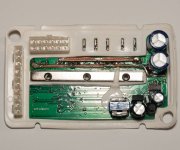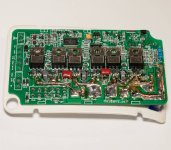Recently I have changed mosfets in my Golden Motor Magic controller (marked as 30/50A 1kW max and used with Golden Motor Magic Pie 2 motor). Originally there were six IRF1407 and I replaced them with IRFB7730. Before modding it maxed continuous at about 27A/1500W (14s LiPo battery) without any problems. I have beefed copper bus and traces on PCB, added thermal compound on the fets (originally it was only between insulator sheet and heatsink) and also slightly changed shunt value. Now it goes up to 60A/3kW and the temperature (I have installed temperature sensor on the heatsink directly where the fets on the other side are) stays fairly low all the time (mostly in 20-30°C region, never seen over 40°C). I have to say that we have temperatures between 5-15°C outside right now and the controller is well placed for good cooling.
So, what do You think about this build and what opinion do You have about pushing it higher? Before increasing the current I am prepared to beef everything even more and to add some capacitors close to the fets and also to the supply line near the controller input (there is no space in the controller for electrolytic caps). I don´t think heat is an issue now, I only fear some other problems. It would be great to hear someone more experienced in this stuff before I learn it the hard way...
Adding some photos to get you in picture:
So, what do You think about this build and what opinion do You have about pushing it higher? Before increasing the current I am prepared to beef everything even more and to add some capacitors close to the fets and also to the supply line near the controller input (there is no space in the controller for electrolytic caps). I don´t think heat is an issue now, I only fear some other problems. It would be great to hear someone more experienced in this stuff before I learn it the hard way...
Adding some photos to get you in picture:




